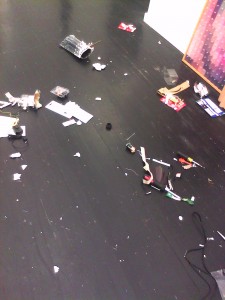Vanessa Roa September 28, 2011
Major Studio: Interface I D+T MFA
Assignment #4: Reflective on Scrapyard Challenge
Guiding Questions:
1.What kind of material affordances does your object provide? How does this influence the way in which another person would interact with your object? How have the affordances of your object changed from the original artifacts you started with?
2. Using the definition provided by Houde & Hill, is your object a prototype? Yes or No? What is your reasoning?
3. What is your understanding of the system image vs. the conceptual model of the workings of your artifact? How do they diverge?
4. How both specifically and in more general terms is the “electronic object” different from the “non-electronic object?” Do they differ at all?
Although I feel I made many mistakes, I learned quite a bit at the Scrapyard Challenge, including how to build an instrument that works with an input and power switch. After seeing what my other classmates made, I felt overwhelmed at the fact that I knew nothing about how to build anything and was surprised when my instrument worked. It seemed way more complicated than I had imagined, but it was an experience that I look forward to recreating. If I could do this experience all over again, I would have approached this by perhaps using some glue gun, or bringing more supplies with me. With that said, I don’t have any regrets, this was an enlightening experience. Plus, I learned how to soldier and make an instrument.
My object provides the affordance of creating musical notes by turning the hands of the clock to touch certain areas on the foil to produce a note. When I initially started my project, I came in with an abundance of materials, many of which I felt overwhelmed with, as I didn’t know what to do with all of the objects at my disposal. Overtime, those items dumbed down to one ugly broken clock with a dead battery and lots of tin foil (which was also, slowly wind down to one sheet). In reality, those two things were all I needed. With not much at our disposal, a group member of mine came up with a concept to use a clock that unbeknownst to her, was mine. I suggested perhaps gluing down the tin foil to the metal knobs so that it could pick up on the electric charge. We ended up using some PVC insulation tape and many many wires later, the clock went in for it’s first testing.
When I started with my project, my clock was simply broken and I was curious as to how I would be able to fix it. Considering that I haven’t really thought of how far along I was going to push the concept of my instrument when I was making it (just being able to complete it on time) At first, I contemplated whether my clock was a completed finished product, as is, or whether I would consider it a prototype. I think after much debate, I would say it’s definitely a prototype. If I could, I would have my clock play several different notes as you turned the hands, and rewire some of the hands so that it would be able to turn more easily. According to the definition laid out by Houde and Hill, my concept was simply an idea that was meant to lay out how it would be used by a designer to explore or demonstrate some aspect of the future artifact. Since I was only able to create the object to the extent that it played a note, it filled it’s purpose as a prototype, meant to express the idea of how it would be used should it have been developed further. If I were to have more time, I would adjust the weak aluminum foil and create more notes for the instrument to play.
I wondered what it would take to make my object run on electricity so that I could use it for it’s intended purpose. But then, I began to brainstorm; did my object stop being an electronic object because it wasn’t connected to an amp? I wondered what and where lied a difference between objects that stand alone on battery charged electricity and those that require some sort of electricity to be able to run. Much like my instrument, I saw a connection between the way most of my appliances and electronics ran through outlets as no different. I’m hoping to either buy an amp and create music on my own one day and hope to create a battery powered version of my model eventually. However, it would also require more work to create sounds on it’s own. It would be an idea worth both experimenting with and exploring.



